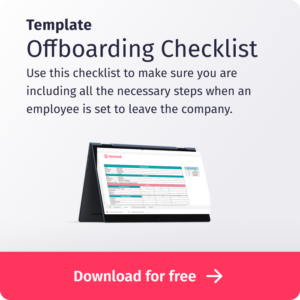The Maryland Worker Adjustment and Retraining Notification (WARN) Act safeguards workers, families, and communities during workforce changes, such as plant closings and mass layoffs. Here, we provide an overview of its components and enforcement, ensuring compliance and employee rights. Read on to learn how to issue a WARN notice in Maryland and everything else you need to know about the WARN Act in MD.
TABLE OF CONTENTS
- Does Maryland have WARN Act?
- What is the Maryland WARN Act?
- WARN notices in Maryland
- What Triggers the WARN Act in Maryland?
- Maryland WARN Act Requirements
- How is the WARN Act Enforced in Maryland?
- Offboarding your workforce during a layoff
- Offboarding solutions 🚀
Does Maryland have WARN Act?
Over half of the states, including Maryland, lack their own state-level WARN Act. However, this doesn’t mean Maryland workers are without protections! Rest assured, Federal WARN Act regulations still extend coverage to employees in Maryland. The state requires employers to submit and issue WARN notices to workers, providing information on anticipated mass layoffs and plant closures and details on the number of affected workers.
Some states are not only regulated by the federal WARN Act, like Ohio, Pennsylvania, Georgia, North Carolina, Arizona, and Florida, but have their own requirements and regulations specified in their so-called mini-WARN Acts. These states include: California, New York, New Jersey, Illinois, and more, all of which you can read about on our blog.
What is the Maryland WARN Act?
Essentially, Maryland’s WARN Act is there to protect workers facing layoffs or plant closures. Employers in Maryland are mandated to provide advance notice to employees when aware of impending closures or layoffs. The logic behind this is that it gives employees enough time to explore their job options and find some kind of safety net. Bear in mind that the WARN Act operates independently of the Fair Labor Standards Act (FLSA), which establishes guidelines for minimum wage, overtime, and unemployment benefits. Be careful not to confuse the FLSA with the Family and Medical Leave Act (FMLA) in Maryland – it’s a common mistake!
On a similar note, however, Maryland holidays are determined both federally, and locally per state. Check out our federal holiday calendar for an updated and complete list.
WARN notices in Maryland
WARN notices in Maryland require 60 days’ advance notification for employees facing layoffs or plant closures. If union workers are involved, notification is directed to union representatives rather than individual employees. Yes, there’s no specific template for this, but it does still have to be in writing and cover the most crucial information, such as:
- The site and date of closure or layoffs
- Reasons for the action
- Whether the loss is permanent or temporary
- Affected job titles
- Unions
- Number of employees
- Follow-up contact information
See previously issued WARN notices for the state of Maryland here.
Who do Maryland employers have to give a WARN notice?
Employers covered by the act must provide written notice to affected workers, labor unions representing these workers, the State Rapid Response Coordinator, and the chief elected official of the local government where the employment site is located. Be careful with timings; this must be delivered at least 60 days before the anticipated plant closing or mass layoff.
What Triggers the WARN Act in Maryland?
There are a few specific situations that trigger the WARN Act in Maryland, which include the following:
1. Plant closings affecting 50 or more employees for at least 30 days.
2. Mass layoffs involving at least 500 full-time employees.
3. Mass layoffs involving at least 50 full-time employees, constituting 33% or more of the employer’s workforce.
4. Plant closings or layoffs extended over 90 days.
What is a plant closing?
When an employment site or facility is shut down and 50 or more employees are lost during a 30-day period, it is considered a plant closing.
What are mass layoffs?
When a mass layoff occurs that does not result from a plant closing, but leads to an employment loss for 500 or more employees during a 30-day period, or for 50-499 employees if they constitute at least 33% of the employer’s active workforce.
What are extended layoffs?
When the cumulative employment losses for two or more groups of workers, each falling below the minimum threshold for notice, reach the threshold level during any 90-day period for either a plant closing or mass layoff.
Do you know the difference between layoffs, a reduction in force, and firing?
Maryland WARN Act Requirements
In Maryland, employers are covered by the WARN Act if they have 100 or more employees, but this excludes people with less than six months of service in the last 12 months or those working an average of less than 20 hours per week. Keep in mind that the Act only applies to certain employers, including:
- Private, for-profit employers
- Private, nonprofit employers
- Public and quasi-public entities operating in a commercial context.
In a similar way, only some types of employees are entitled to notice under the WARN Act, these being:
- Hourly and salaried workers
- Managerial and supervisory employees.
NOTE: Business partners are not entitled to notice.
The core focus of WARN Act requirements in Maryland is on notification, the idea being to give people enough time to make an alternative plan! This is why employers must provide advance notice before a change in employment that affects a large number of employees.
The state of Maryland makes recommendations, too, regardless of the law. It encourages all employers to issue a WARN notice by meeting the WARN act minimum employee threshold or any of the other criteria, even if they aren’t required to by law. Essentially, as much notice as possible is best for employees as it can take time to find another job or some kind of safety net to support themselves!
How is the WARN Act Enforced in Maryland?
Enforcement of the Maryland WARN Act is carried out through the United States District Courts. Workers, their representatives, and units of local government have the right to bring individual or class-action suits against employers believed to violate the Act. At this point, the court can award reasonable attorney’s fees to the prevailing party as part of the costs, so bear this in mind!
But what happens if you don’t comply? Well, violations of the WARN Act may result in back pay for affected employees and penalties of up to $500 per day of violation. This even includes failure to adhere to notification period requirements. Employers must settle liabilities with aggrieved employees within three weeks of closure or layoff; if they don’t, they could be at the receiving end of individual or class-action lawsuits in the U.S. District Court.
Still unsure about any of this? Consult with Maryland labor lawyers to address potential violation claims and always read the official sources before making any decisions. And remember that laws are subject to change!
Why is the Maryland WARN Act important?
It can be difficult to wrap your head around the details of the Maryland WARN Act! Nevertheless, HR managers need to know it inside and out in order to deal with workforce changes in a compliant way and ensure the rights of employees are upheld during major changes. This guide covers the key aspects to ensure managers have the knowledge they need!
Related: Compliance calendar for HR
Offboarding your workforce during a layoff
Once you’ve followed all the required steps mandated by Maryland during plant closings and mass layoffs, it’s time to begin the offboarding process at your company. Offboarding so many employees at the same time can be a time consuming and costly process, but with the right HR software, it can be easy.
How to offboard employees with HR software
Factorial simplifies the offboarding process, streamlining tasks and ensuring a smooth transition for departing employees. With Factorial, you can efficiently manage exit procedures, such as collecting company assets, updating access permissions, and conducting exit interviews. Offboarding software simplifies the entire process from start to finish.
Key Features for offboarding during layoffs:
1. Clear Communication: Easily explain departure details to the departing employee, including the last day of work, return of company property, and other essential information.
2. Task Automation: Automate offboarding tasks, such as revoking system access, updating records, and notifying relevant departments, to save time and minimize the risk of oversight.
3. Documentation and Compliance: Stay compliant by generating necessary documentation, such as termination letters and exit surveys, helping you maintain a comprehensive record of everything that takes place during offboarding.
4. Access Control: Centralize the management of who controls what, making it simple to revoke access to company systems and confidential information, safeguarding your organization’s data.
By utilizing Factorial for offboarding, HR managers can enhance efficiency, maintain compliance, and provide a positive experience for departing employees.





